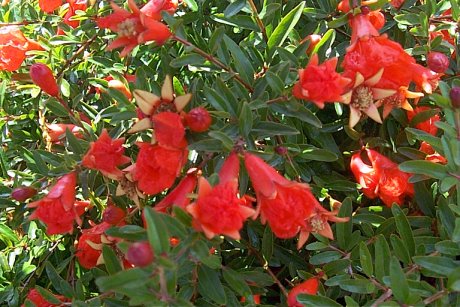| Botanical Name: Punica granatum | |
| Common Name: Pomegranate |

-
Anatomy
-
Culture
-
Design
Plant Type
Shrub
Height Range
6-12'
Flower Color
Orange
Flower Season
Summer
Leaf Color
Dark Green
Bark Color
Brown
Fruit Color
Red
Fruit Season
Fall
Sun
Full
Water
Low
Growth Rate
Moderate
Soil Type
Clay, Loam, Rocky
Soil Condition
Average, Rich, Well-drained
Soil pH
Neutral, Basic
Adverse Factors
n/a
Design Styles
Mediterranean, Ranch, Spanish
Accenting Features
Fall Color, Showy Flowers
Seasonal Interest
Spring, Summer, Fall
Location Uses
Background, Shrub Border, Patio
Special Uses
Container
Attracts Wildlife
n/a
Information by: Stephanie Duer
Photographer: Greg Applegate/Thompson
Photographer: Greg Applegate/Thompson
-
Description
-
Notes
Pomegranate is a deciduous shrub growing about 6 to 10 feet tall and probably half as wide (it grows larger in a milder climate). In proper growing conditions, trumpet-shaped, orange-red flowers bloom throughout the summer singlely or in clusters at the branch ends. Flowers give way to orange-sized, leathery-skinned, globose fruits (pomegranates to 2-4†diameter) that ripen to yellow tinged with red. Fruit interior is divided into compartments packed with fleshy, juicy, edible sacs (arils) that surround the seeds. The juicy sacs (along with the seed inside each) are edible fresh or may be incorporated into jams or jellies. It is not dependably hardy here, but you may be able to maintain a plant through proper diligence.
Winter hardy to USDA Zones 8-11, though there are a few around the valley planted next to south or west facing walls. Best grown in organically rich, dry to medium moisture, well-drained soil in full sun. Plants fruit best in areas with long, hot, dry summers (90s F) and cooler winters. Water plants regularly. Remove root suckers as they develop. Root mulch helps control unwanted weed growth. Prune as needed in late winter. Mulch heavily to help over-winter. Or, grow in containers placing them outdoors in bright, mostly sunny locations in summer with regular application of moisture; overwinter indoors in bright, cool locations with reduced watering. It grows down in St. George.